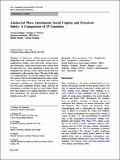| dc.contributor.author | Molcho, Michal | |
| dc.date.accessioned | 2012-05-23T13:29:33Z | |
| dc.date.available | 2012-05-23T13:29:33Z | |
| dc.date.issued | 2009-06-17 | |
| dc.identifier.citation | Dallago, L., Santinello, M., Perkins, D.D, Boyce, W., Molcho, M. & Morgan, A. (2009). Adolescent place attachment, social capital, and perceived safety: a comparison of 13 countries. American Journal of Community Psychology, 44(1-2), 148-60. | en_US |
| dc.identifier.issn | 1573-2770 | |
| dc.identifier.uri | http://hdl.handle.net/10379/2793 | |
| dc.description.abstract | In adolescence, children become increasingly independent and autonomous, and spend more time in neighborhood settings away from home. During mid-to-late adolescence, youth often become more critical about the place they live. Their attachment to home and even community may decrease as they explore and develop new attachments to other specific places. The aim of this study is to understand how 15-year-old students from 13 countries perceive their local neighborhood area (place attachment, social capital and safety), and how these different community cognitions are interrelated. We hypothesize that their place attachment predicts safety, and that the relationship is mediated in part by social capital. Result show that, despite cross-cultural differences in neighborhood perceptions, the proposed theoretical model fits robustly across all 13 countries. | en_US |
| dc.format | application/pdf | en_US |
| dc.language.iso | en | en_US |
| dc.publisher | Springer | en_US |
| dc.rights | Attribution-NonCommercial-NoDerivs 3.0 Ireland | |
| dc.rights.uri | https://creativecommons.org/licenses/by-nc-nd/3.0/ie/ | |
| dc.subject | Place perceptions | en_US |
| dc.subject | Trust | en_US |
| dc.subject | Neighboring | en_US |
| dc.subject | Fear | en_US |
| dc.subject | Comparative | en_US |
| dc.subject | International | en_US |
| dc.subject | Health behaviour in school-aged children (HBSC) | en_US |
| dc.subject | Health Promotion | en_US |
| dc.title | Adolescent place attachment, social capital, and perceived safety: a comparison of 13 countries. | en_US |
| dc.type | Article | en_US |
| dc.identifier.doi | 10.1007/s10464-009-9250-z | |
| dc.local.publishedsource | http://dx.doi.org/10.1007/s10464-009-9250-z | en_US |
| dc.description.peer-reviewed | peer-reviewed | en_US |
| dc.contributor.funder | World Health Organization | en_US |
| nui.item.downloads | 991 | |


